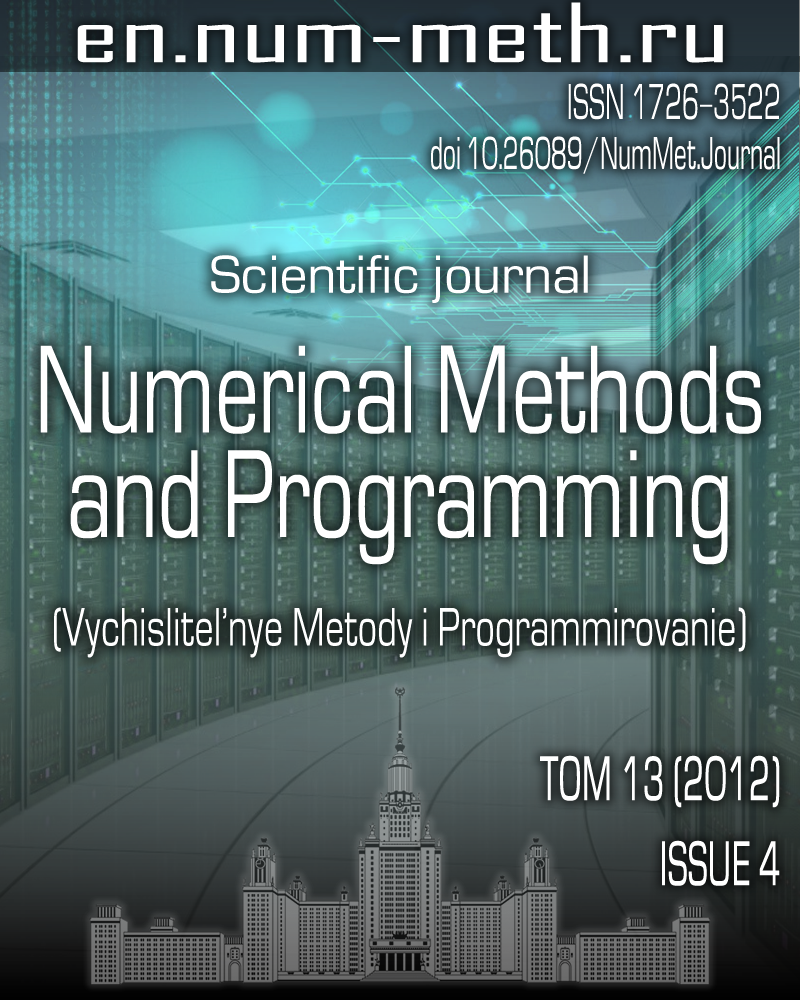Influence of genetic algorithm parameters on the docking efficiency with the SOL program
Keywords:
docking, drug design, genetic algorithm, global optimization, parameterizationAbstract
The key genetic algorithm parameters and their influence on the docking efficiency implemented in the SOL parallel program are analyzed. Tests were carried out with complexes of uPA (urokinase-type plasminogen activator) and co-crystallized ligands and were directed on the research of new inhibitors of uPA as potential antitumor drugs. The optimal parameters of the genetic algorithm are obtained for the single-run mode, i.e., for the docking of a single molecule, and for the virtual screening mode, i.e., for the docking of compound libraries. Tests were performed on the CHEBYSHEV and LOMONOSOV cluster supercomputers.
References
- Садовничий В.А., Сулимов В.Б. Суперкомпьютерные технологии в медицине // Суперкомпьютерные технологии в науке, образовании и промышленности / Под ред. В.А. Садовничего, Г.И. Савина, Вл.В. Воеводина. М: Изд-во Моск. ун-та, 2009. 16-23.
- Klebe G. Virtual ligand screening: strategies, perspectives and limitations // Drug Disc. Today. 2006. 11. 580-594.
- Alvarez J., Shoichet B. Virtual screening in drug discovery. Boca Raton: CRC Press, 2005.
- Kitchen D.B., Decornez H., Furr J.R., Bajorath J. Docking and scoring in virtual screening for drug discovery: methods and applications // Nature Reviews Drug Discovery. 2004. N 3. 935-949.
- Pegga S.C.-H., Harescob J.J., Kuntza Ir.D. A genetic algorithm for structure-based de novo design // J. Computer-Aided Molecular Design. 2001. 15, N 10. 911-933.
- Oshiro C.M., Kuntz I.D., Dixon J.S. Flexible ligand docking using a genetic algorithm // J. Computer-Aided Molecular Design. 1995. N 9. 113-130.
- Baxter C.A., Murray C.W., Clark D.E., Westhead D.R., Eldridge M.D. Flexible docking using tabu search and an empirical estimate of binding affinity // Proteins: Structure, Function, and Bioinformatics. 1999. N 33. 367-382.
- Namasivayam V., Günther R. Pso@autodock: a fast flexible molecular docking program based on swarm intelligence // Chemical Biology &; Drug Design. 2007. 70, N 6. 475-484.
- Goodsell D.S., Olson A.J. Automated docking of substrates to proteins by simulated annealing // Proteins. 1990. 8, N 3. 195-202.
- Morris G.M., Goodsell D.S., Halliday R.S., Huey R., Hart W.E., Belew R.K., Olson A.J. Automated docking using a Lamarckian genetic algorithm and an empirical binding free energy function // J. Comput. Chem. 1998. 19. 1639-1662.
- Deng Y., Roux B. Computations of standard binding free energies with molecular dynamics simulations // J. Phys. Chem. B. 2009. 113. 2234-2246.
- Frenkel D., Smit B. Understanding molecular simulation: from algorithms to applications. New York: Academic Press, 2007.
- Zwanzig R.W. High-temperature equation of state by a perturbation method. I. Nonpolar gases // J. Chem. Phys. 1954. 22. 1420-1426.
- Morris G.M., Huey R., Lindstrom W., Sanner M.F., Belew R.K., Goodsell D.S., Olson A.J. AutoDock4 and AutoDockTools4: automated docking with selective receptor flexibility // J. Comput. Chem. 2009. 30. 2785-2791.
- Jones G., Willett P., Glen R.C., Leach A.R., Taylor R. Development and validation of a genetic algorithm for flexible docking // J. Mol. Biol. 1997. 267. 727-748.
- Verdonk M.L., Cole J.C., Hartshorn M.J., Murray C.W., Taylor R.D. Improved protein-ligand docking using GOLD // Proteins. 2003. 52. 609-623.
- Thomsen R., Christensen M.H. MolDock: a new technique for high-accuracy molecular docking // J. Med. Chem. 2006. 49. 3315-3321.
- Taylor J.S., Burnett R.M. DARWIN: a program for docking flexible molecules // Proteins. 2000. 41. 173-191.
- Clark K.P., Jain A.N. Flexible ligand docking without parameter adjustment across four ligand receptor complexes // J. Comput. Chem. 1995. 16. 1210-1226.
- Pei J.F., Wang Q., Liu Z.M., Li Q.L., Yang K., Lai L. PSI-DOCK: towards highly efficient and accurate flexible ligand docking // Proteins-Structure Function and Bioinformatics. 2006. 62, N 4. 934-946.
- Zhao Y., Sanner M.F. FLIPDock: docking flexible ligands into flexible receptors // Proteins. 2007. 68. 726-737.
- Stroganov O.V., Novikov F.N., Stroylov V.S., Kulkov V., Chilov G.G. Lead finder: an approach to improve accuracy of protein-ligand docking, binding energy estimation, and virtual screening // J. Chem. Inf. Model. 2008. 48. 2371-2385.
- Романов А.Н., Кондакова О.А., Григорьев Ф.В., Сулимов A.В., Лущекина С.В., Мартынов Я.Б., Сулимов В.Б. Компьютерный дизайн лекарственных средств: программа докинга SOL // Вычислительные методы и программирование. 2008. 9. 213-233.
- Оферкин И.В., Сулимов А.В., Кондакова О.А., Сулимов В.Б. Реализация поддержки параллельных вычислений в программах докинга SOLGRID и SOL // Вычислительные методы и программирование. 2011. 12, o 1. 205-219.
- Sinauridze E.I., Romanov A.N., Gribkova I.V., Kondakova O.A., Surov S.S., et al. New synthetic thrombin inhibitors: molecular design and experimental verification // PLoS ONE. 2011. 6, N 5. e19969 (doi:10.1371/journal.pone.0019969).
- Садовничий В.А., Сулимов В.Б., Каткова Е.В., Романов А.Н., Сулимов А.В., Оферкин И.В., Стамбольский Д.В., Белоглазова И.Б., Ткачук В.А. Молекулярное моделирование для разработки новых лекарств на основе ингибиторов урокиназы // Постгеномные исследования и технологии / Под ред. С.Д. Варфоломеева. М.: Изд-во Моск. ун-та, 2011. 103-140.
- Choong P.F., Nadesapillai A.P. Urokinase plasminogen activator system: a multifunctional role in tumor progression and metastasis // Clin. Orthop. Relat. Res. 2003. 415S. S46-S58.
- Romanov A.N., Jabin S.N., Martynov Y.B., Sulimov A.V., Grigoriev F.V., Sulimov V.B. Surface generalized Born method: a simple, fast and precise implicit solvent model beyond the Coulomb approximation // J. Phys. Chem. 2004. A 108. 9323-9327.
- The Protein Data Bank (http://www.rcsb.org/pdb/home/home.do).
- Hetenyi C., van der Spoel D. Efficient docking of peptides to proteins without prior knowledge of the binding site // Protein Sci. 2002. 11. 1729-1737.
- Taylor J.S., Burnett R.M. DARWIN: a program for docking flexible molecules // Proteins. 2000. 41. 173-191.
- Douglet D., Thoreau E., Grassy G. A genetic algorithm for the automated generation of small organic molecules: drug design using an evolutionary algorithm // J. Computer-Aided Molecular Design. 2000. 14. 449-466.
- http://keenbase.ru/file/solparam_add_1.pdf
- http://keenbase.ru/file/solparam_add_2.pdf
- http://keenbase.ru/file/solparam_add_3.pdf
- The Community Structure-Activity Resource (CSAR) (http://www.csardock.org/index.jsp).
Downloads
Published
20-11-2012
How to Cite
Каткова Е. Influence of Genetic Algorithm Parameters on the Docking Efficiency With the SOL Program // Numerical Methods and Programming (Vychislitel’nye Metody i Programmirovanie). 2012. 13. 536-550
Issue
Section
Section 1. Numerical methods and applications

